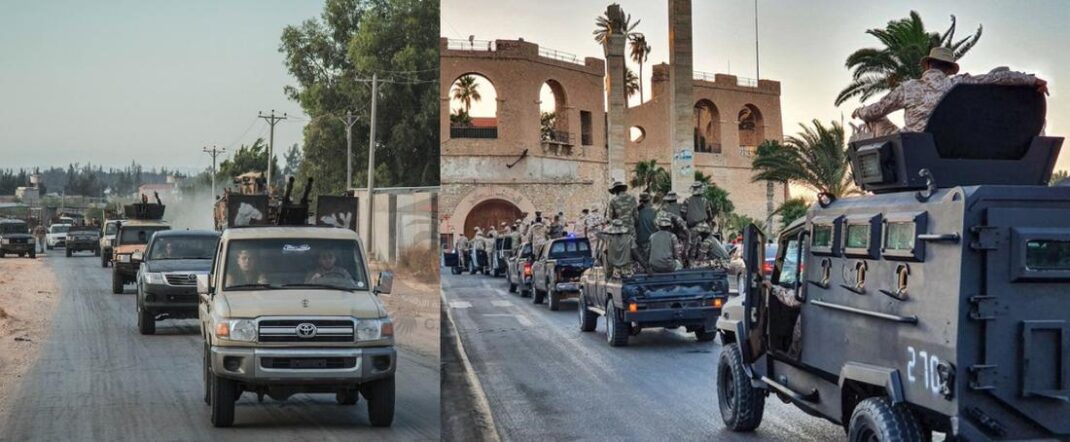By Emadeddin Badi
 In contemporary Libya, a panoply of state and non-state actors forms an unconventional security apparatus.
In contemporary Libya, a panoply of state and non-state actors forms an unconventional security apparatus.
PART ONE
The emergence of the state’s hybrid security architecture features prominently in the discussions surrounding the collapse of the Libyan state post–2011, as well as the fragmentation of its political and social orders.
In recent years, the policies of Libya’s transitional authorities have contributed to institutionalizing “hybridity” as a defining feature of the country’s security architecture.
Since the revolution, security actors have become increasingly entrenched as Libya’s weakening central government relinquishes its power to them, often bestowing upon select groups official affiliations by means of recognition and broad mandates.
They have, in effect, blurred the lines between what is formal and informal, official and unofficial. What this analysis often omits is that the hybrid nature of Libya’s security sector did not emerge post–2011.
Hybridity is a longstanding feature of the state’s security architecture, one that was exacerbated by Muammar Gaddafi’s centralization of governance during his four-decades-long rule.
By 2011, the Gaddafi regime’s ability to monopolize violence relied on a perpetual cycle of coup-proofing the Libyan armed forces. This process was concomitant with a covert state-sponsored undertaking to create informal, parallel security structures centered around loyalty to Gaddafi’s persona and mandated to protect Gaddafi as opposed to the nation state.
This security sector hybridity shaped the alignment of formal and informal actors with or against Gaddafi in 2011 and laid the foundation for the competition over legitimacy, affiliations, and labels, which ensued after his demise.
The fallout from the revolution drastically transformed patterns of securitysector hybridization. In post–2011 Libya, half-hearted attempts at stabilization, European disunity, and overreach by regional powers entrenched a hyper-localized and fragmented security landscape.
Against this backdrop, hybridity was no longer a willful policy spearheaded by a totalitarian ruler. Instead, it became an unavoidable reality that enmeshed local divisions amongst Libya’s domestic power brokers with the zero-sum calculations of foreign sponsors from whom Libyan actors sought support.
Western states’ policy of containment toward Libya dovetailed well with the ambitions of some regional powers. They saw, amid the post–revolutionary transitions, an opportunity to shape regional orders around their preferred modes of governance and their ideology.
This convergence of opportunism, short-termism, ambivalence, and zero-sum calculations led Libya to ruin, as its splintered security sector became the arena in which all these contradicting policies and divides played out violently.
This analysis contends with the reality that hybridity in Libya’s security sector is not a novel phenomenon, but rather a persistent feature that manifested in new ways post–2011. It briefly highlights how Gaddafi’s shaping and reshaping of the security sector exacerbated hybridity pre–2011.
Among other divisive legacies, this hybridity led to competition over revolutionary legitimacy between armed actors post–2011. Against a backdrop of intra-communal conflicts, hybridity transformed from a regime resilience device to a condition that diluted the very notion of state sovereignty—a dilution catalyzed by the belligerence of foreign actors.
While the Gaddafi-era hybridity was essentially the byproduct of a security apparatus built around personal loyalty to his own persona, the hybridity that emerged in post–revolutionary Libya was initially a symptom of—and subsequently a reason for—the failure to negotiate a social contract that defined the nation’s interests and structured the security sector around them. This “neo-hybridity” will continue to affect the trajectory of the Libyan state for years to come.
Understanding the evolution of hybridity provides important insights into key causes of Libya’s descent into civil war in 2014 and 2019. More broadly, studying the transition between the old hybridity and the new, more acute, form of hybridity has relevance beyond Libya, particularly in other states susceptible to transition or where hybrid security sectors are the norm.
Reckoning with the challenges created by either form of hybrid security architecture also has far-reaching implications on predominantly Weberianinfluenced doctrinal approaches to state-building, such as security sector reform (SSR).
Finally, such analysis asks important questions about the applicability of Westphalian paradigms, which characterize the “state” by its monopoly on the use of force and its legal–rational norms and institutions.
State–Engineered Hybridity in the Gaddafi Era
One can explain the defection or mobilization of Gaddafi’s armed forces in 2011 by deconstructing the development of the security corps over the course of his rule.
This comes as no surprise since, in 1969, Gaddafi himself led a group of military officers—dubbed the Revolutionary Command Council (RCC)—to oust Libya’s King Idrīs Al-Sanussi in a bloodless coup.
The Libyan military was therefore an apparatus that was part and parcel of the regime change of 1969, and the ability of the military to transcend tribal divides was a key factor that enabled Gaddafi’s power grab.
In turn, the military was promptly branded and equipped as the government’s new bulwark against any potential threat. In the two decades that followed the revolution, Gaddafi took advantage of the surpluses generated from Libya’s oil boom to invest in various military procurement programs.
Yet, owing to his military-enabled rise to power, Gaddafi recognized the pivotal role that the armed forces could have in positively or negatively shaping power relations. What cemented the perception of the formal “army” as a threat was an attempted coup d’état launched against him in 1975 by members of his very own RCC.
Though the attempt failed, and the plotters were arrested and executed, the event paved the way for the emergence of hybridity in Libya’s state security apparatus. Along with the initial impetus for extravagant spending on military procurement, Gaddafi focused on removing bureaucratic and legal obstacles to totalitarian rule under the veneer of populism.
By destroying various political and economic institutions, Gaddafi repurposed the country’s bureaucratic structures into overstaffed mediums for regime indoctrination through which he spread his own ideology. However, Gaddafi’s establishment of a totalitarian system was not achieved through governance or ideology alone; these were key processes that enabled the successful hybridization of Libya’s security apparatus.
This transition to parallel informalized security structures required an ability to exert influence within Libya’s different social spheres, if only to recruit individuals who would value loyalty to Gaddafi above loyalty to the state.
Removing perceived bureaucratic and institutional obstacles may have created the space for this process to unfold, but ideology drove the transition. Indeed, Gaddafi partially succeeded in socially engineering significant parts of Libya’s society.
The process revolved around diluting the relevance and sovereignty of the Libyan state in favor of other abstract but personalized concepts, such as the Jamahiriya and the Cultural Revolution, with Gaddafi as its “Brotherly Leader and Guide.”
This socialization process resulted in the emergence of an intricate web of uncoordinated mechanisms where formal and informal military and security institutions co-existed and reported directly to Gaddafi.
Gaddafi’s aversion to formal state institutions, which he made clear in his Green Book, manifested as a growing ambivalence toward the formal armed forces. This ambivalence turned to outright distrust after the attempted coup against him in 1975.
***
Emadeddin Badi is a Libyan independent consultant and scholar who specializes in governance, postconflict stabilization, hybrid security structures and peacebuilding. He is currently a Senior Analyst at the Global Initiative Against Transnational Organized Crime and an Advisor at the Geneva Centre for Security Sector Governance (DCAF). He is also a non-resident Senior Fellow with the Middle East Program at the Atlantic Council.
____________
Source: the brown journal of world affairs





